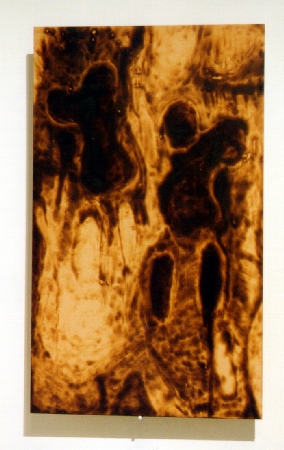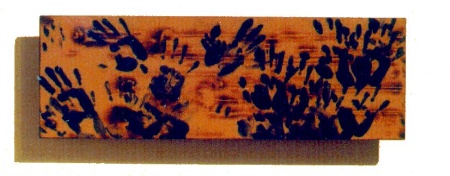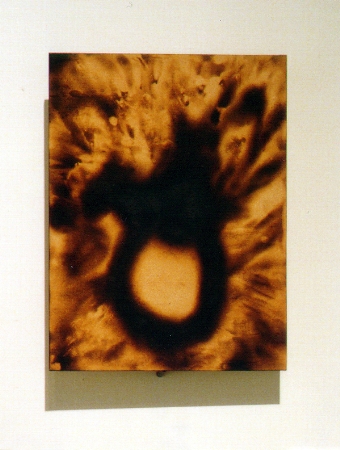| Back to show catalogue | ||
|
The Trace of the Immediate - Jenean Plumb Wood  Yves Klein's fascination with fire could be considered extraordinary.
His 1961 exhibition, at the Museum Haus Lange in Krefeld, Germany, sparked
his interest in tracing the presence of fire which lead him to produce
his series of fire paintings and prints. The Krefeld exhibition entitled
Yves Klein: Monochrome und Feuer (Monochrome and Fire) had a wide range
of his work including his monochromes, sponge reliefs, sponge sculptures,
anthropometries and cosmogonies. It also included a small void room
and his drawings of his water and fire wall and fountain designs.
Perhaps the most spectacular of all was the installation of his Fire Sculpture
and Wall of Fire on the museum's lawn. The Fire Sculpture consisted
of two large columns of flame that shot up from the ground into the air
measuring about three meters. With the Wall of Fire, fifty Bunsen
burners in a grid-like pattern were set upon their side so that their rosette-like
flames created a vertical wall of fire. The structure of the grid,
measuring one by two meters, was raised about a meter above the ground.
At the exhibition's opening, Klein arranged for the fire display to be
lit while guests gathered around. Burning side by side, the wall
and the columns seemingly had a striking effect on all those who were present
when the display "suddenly illuminated the twilight." (Stich: 223)
This left those who witnessed the fire spectacle with "Prometheus and Empedocles
complexes: attraction, repulsion, bedazzlement÷[and]÷apprehension." (Restany:102)
The fire creates attraction where bedazzlement is an effect of its warm
brilliancy whereas repulsion and apprehension are brought on by its potential
to harm. On the one hand, the creative and destructive energy in
fire makes Klein's fascination with the medium understandable. On
the other hand, the warmth that fire creates is as powerful and in this
duality, Klein's fascination with fire is demonstrated.
Yves Klein's fascination with fire could be considered extraordinary.
His 1961 exhibition, at the Museum Haus Lange in Krefeld, Germany, sparked
his interest in tracing the presence of fire which lead him to produce
his series of fire paintings and prints. The Krefeld exhibition entitled
Yves Klein: Monochrome und Feuer (Monochrome and Fire) had a wide range
of his work including his monochromes, sponge reliefs, sponge sculptures,
anthropometries and cosmogonies. It also included a small void room
and his drawings of his water and fire wall and fountain designs.
Perhaps the most spectacular of all was the installation of his Fire Sculpture
and Wall of Fire on the museum's lawn. The Fire Sculpture consisted
of two large columns of flame that shot up from the ground into the air
measuring about three meters. With the Wall of Fire, fifty Bunsen
burners in a grid-like pattern were set upon their side so that their rosette-like
flames created a vertical wall of fire. The structure of the grid,
measuring one by two meters, was raised about a meter above the ground.
At the exhibition's opening, Klein arranged for the fire display to be
lit while guests gathered around. Burning side by side, the wall
and the columns seemingly had a striking effect on all those who were present
when the display "suddenly illuminated the twilight." (Stich: 223)
This left those who witnessed the fire spectacle with "Prometheus and Empedocles
complexes: attraction, repulsion, bedazzlement÷[and]÷apprehension." (Restany:102)
The fire creates attraction where bedazzlement is an effect of its warm
brilliancy whereas repulsion and apprehension are brought on by its potential
to harm. On the one hand, the creative and destructive energy in
fire makes Klein's fascination with the medium understandable. On
the other hand, the warmth that fire creates is as powerful and in this
duality, Klein's fascination with fire is demonstrated.
The Krefeld
exhibition described as "classic Klein÷[was]÷imbued with the aura of a
ritual ceremony." (Stich: 223) The ritualizing of Klein's actions
is not surprising. Before the exhibition ended, he rushed off to
give thanks to Saint Rita with his offering of his ex-voto box. "But
the text of thanksgiving accompanying the ex-voto represented much more
than an act of allegiance. Yves placed the whole of his past, present
and future work under the protection of Saint Rita." (Restany: 103)
This ritual proved necessary to Klein; he not only proved his humility
in the stride of success but also it insured his creativity. This
trip to Cascia arguably allowed him to be enlightened, witnessed with his
fire paintings. The last day of the exhibition, February 26, 1961,
he summoned Paul Wember, the museum director, to witness, along with the
public, the beginning of the fire paintings.
entailed holding a sheet of paper or compressed board to the flames for a few seconds. Depending on the intensity of the flame and the duration of the combustion, the fire left a smokey ambience, a scorch figuration, a black density, a charred residue, a crackling veneer, scarring splotches or a burnt hole. (Stich :224)The Bunsen burners produced shadows and rosette patterns whereas the columns of flame produced very different markings, ovoid in shape. Each type of marking appears separately or together depending on Klein's exploration of the newly discovered living brush. The works F42 and F45 illustrate his exploration and his testing of the living brush of fire. F42 combines the rosette markings with a large ovoid whereas F45 has only rosettes repeated several times of different intensities keeping in line with the gird pattern of the Wall of Fire. Pierre Restany, a friend and critic of Klein, questions the validity of F45 as he states that it has "no relationship with the configuration of the framework for the original Wall." (Restany: 106) One might argue that F45 contains an obvious grid pattern, contradictory to what Restany claims. Despite this disagreement, both of these works could be considered beautiful in their display of the duality of fire.
Klein not only used water but also incorporated paint into his experimenting with fire. The fire-colour paintings that he created were done by, either painting the compressed board first and then exposing it to fire or he would paint the board after the burning process emphasising certain fire markings. He also used nude models, like with his anthropometries, to imprint the human figure but used water instead of paint. He would spray the model with water, who would than press her body onto the compressed board after which he would immediately burn the imprint of water left behind. This process created similar images to those of his anthropometries, yet the burning is more directly connected to the Hiroshima image of the nuclear blast's victim's body imprint on stone that affected Klein early in his career. Klein's experimenting abruptly ended when it was found out that nude models were on the premises of the Testing Centre of Gaz de France. This not only affected Klein and his work but also the director of the centre who was fired. However, during his time at the centre, Klein produced a great body of work, one hundred and twenty fire paintings in total, which served only to compliment his other bodies of work.
In reproducing Klein's fire paintings, this viewer/reader/artist, has had the opportunity not only to experiment and negotiate with the element of fire but also experience that instant of a moment of time where life itself flickers. It is understood that Klein's fascination with fire was not a mere fixation but a way of living. Klein put his hand into the fire, testing life thus living it to its full potential. It is a rare act, but one that must be heeded so that "We will then be able to join Yves Klein in the eternal present of the glorious body, the corpus glorifications, and plunge ourselves in the Fire in order to take possession of our own Self. Thus we will ourselves be fire." (Restany: 148)
Works Cited Restany, Pierre. Yves Klein: Fire at the Heart of the Void. New York: Journal of Contemporary Art, 1992. Stich, Sidra. Yves Klein, exh. cat. Stuttgart and London: Cantz Verlag and the Hayward Gallery, 1994. |
||
 Klein continues his fire painting at the Testing Centre of Gaz de France
after the Krefeld exhibition. In keeping with his flamboyant and
exuberant character and the element of chance, Klein got permission to
use the facilities; "Not only was it prestigious to work with the
experts at the national gas company, but it was also marked the realization
of Klein's dream to achieve a collaboration between art and science." (Stich:
224) The importance of this collaboration was that it allowed him to solidify
what he was striving for: to record "the presence of absence, the mark
of life÷." (Restany: 109) Working at the Testing Centre allowed him
the liberty to experiment with the fire medium and different canvas materials.
With the use of a flame-thrower, water and Swedish compressed board, engineered
to burn at a slower rate than normal compressed board, Klein had the ability
to regulate the burning process. Through his experimenting, he developed
three approaches to the burning process that enabled him to control the
effect the fire had on the compressed board. The first approach created
"a toned down version of Pollock's dripping technique: the surface and
its area of shadows are literally dusted with a rain of selective spots
and spurts÷" (Restany:123) Klein's second approach produced markings
that appeared like clouds; "the flames trace [took] on cottony and informal
contours." (Restany: 224) His third approach allowed the Žspill traces'
of water to be imprinted onto the compressed board. The vertical
characteristic of these Žspill traces' could "remind one of a bundle of
tropical creepers." (Restany: 224)
Klein continues his fire painting at the Testing Centre of Gaz de France
after the Krefeld exhibition. In keeping with his flamboyant and
exuberant character and the element of chance, Klein got permission to
use the facilities; "Not only was it prestigious to work with the
experts at the national gas company, but it was also marked the realization
of Klein's dream to achieve a collaboration between art and science." (Stich:
224) The importance of this collaboration was that it allowed him to solidify
what he was striving for: to record "the presence of absence, the mark
of life÷." (Restany: 109) Working at the Testing Centre allowed him
the liberty to experiment with the fire medium and different canvas materials.
With the use of a flame-thrower, water and Swedish compressed board, engineered
to burn at a slower rate than normal compressed board, Klein had the ability
to regulate the burning process. Through his experimenting, he developed
three approaches to the burning process that enabled him to control the
effect the fire had on the compressed board. The first approach created
"a toned down version of Pollock's dripping technique: the surface and
its area of shadows are literally dusted with a rain of selective spots
and spurts÷" (Restany:123) Klein's second approach produced markings
that appeared like clouds; "the flames trace [took] on cottony and informal
contours." (Restany: 224) His third approach allowed the Žspill traces'
of water to be imprinted onto the compressed board. The vertical
characteristic of these Žspill traces' could "remind one of a bundle of
tropical creepers." (Restany: 224)
 Klein's fire paintings seem to be an exploration of what lies behind, beneath
and beyond the surface of the material: the spiritual. The
reading or the meaning of his work lies in the process or the Žhappening'
rather than in the work itself; Klein claimed that his works were the ashes
of his art. Through it, he revealed his sense of spirituality through
the materiality at his disposal. He uses fire, one of the four major
elements of life, to demonstrate the Žpresence of absence.' He uncovers
what is unseen by the eyes, untouched by the hand and not traced by the
human soul. Klein rediscovers what humankind has been and is
still striving for: self-awareness, the ability to express Self, either
as an expression in science or in art. Klein takes his expression
further, it is expressed in both science and art. He combines science
with art and art with science, accomplishing the ultimate expression of
Self by combining the element of fire with the act of painting. Fire,
the "trace of the immediate" (Stich: 223) gave Klein the ability to trace
a moment, an instant of time that holds the essential substance of life.
Klein had many influences. The theories of Gaston Bachelard, C.G
Jung, Max Heindel and Eugene Delacroix all played roles in Klein's work
but it was also influenced by the nature of the fire itself. The
flame of fire contains his colour trilogy: blue, rose and gold.
One could say it contains his past, present and future; preserved in the
trace of the immediate, the instant of a moment, the flicker of time that
life expresses itself in.
Klein's fire paintings seem to be an exploration of what lies behind, beneath
and beyond the surface of the material: the spiritual. The
reading or the meaning of his work lies in the process or the Žhappening'
rather than in the work itself; Klein claimed that his works were the ashes
of his art. Through it, he revealed his sense of spirituality through
the materiality at his disposal. He uses fire, one of the four major
elements of life, to demonstrate the Žpresence of absence.' He uncovers
what is unseen by the eyes, untouched by the hand and not traced by the
human soul. Klein rediscovers what humankind has been and is
still striving for: self-awareness, the ability to express Self, either
as an expression in science or in art. Klein takes his expression
further, it is expressed in both science and art. He combines science
with art and art with science, accomplishing the ultimate expression of
Self by combining the element of fire with the act of painting. Fire,
the "trace of the immediate" (Stich: 223) gave Klein the ability to trace
a moment, an instant of time that holds the essential substance of life.
Klein had many influences. The theories of Gaston Bachelard, C.G
Jung, Max Heindel and Eugene Delacroix all played roles in Klein's work
but it was also influenced by the nature of the fire itself. The
flame of fire contains his colour trilogy: blue, rose and gold.
One could say it contains his past, present and future; preserved in the
trace of the immediate, the instant of a moment, the flicker of time that
life expresses itself in.